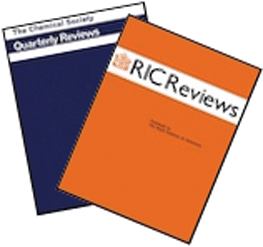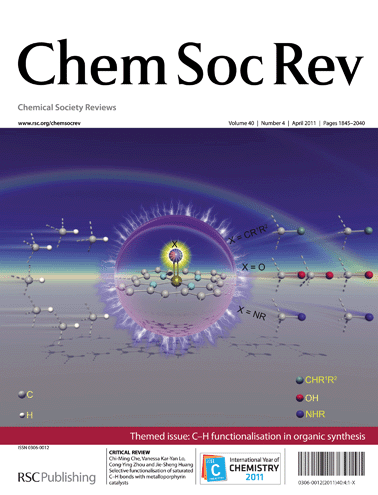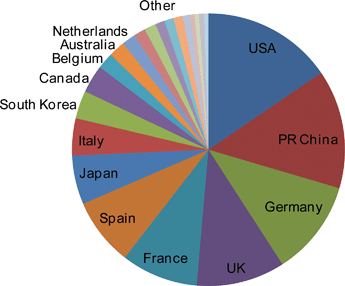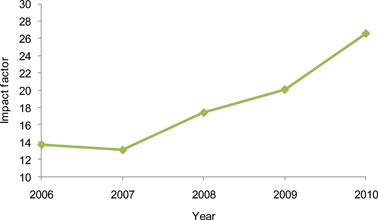![]() Chem Soc Rev has over 600 followers on Twitter. To join the trend and make sure you are one of the first to know the latest journal news, follow us at www.twitter.com/chemsocrev.
Chem Soc Rev has over 600 followers on Twitter. To join the trend and make sure you are one of the first to know the latest journal news, follow us at www.twitter.com/chemsocrev.
Author Archive
Chem Soc Rev in a nutshell. Fact number 9
Chem Soc Rev in a nutshell. Fact number 8
![]() The 2011 issue with the most downloads per article is the C-H Functionalisation in Organic Synthesis themed issue (issue 4).
The 2011 issue with the most downloads per article is the C-H Functionalisation in Organic Synthesis themed issue (issue 4).
The issue is guest edited by Professors Huw Davies, Justin Du Bois and Jin-Quan Yu and is dedicated to the memory of Professor Keith Fagnou.
C-H Functionalisation in Organic Synthesis hosts a collection of 13 Tutorial and Critical Reviews from leading scientists such as Robert Crabtree, Phil Baran, and John Hartwig. Visit the C-H Functionalisation in Organic Synthesis web page to see what this issue has on offer…
Also of interest… Chem Soc Rev fact numbers 1, 2, 3, 4, 5, 6, 7.
Time to hook up the switches
During the early days of any new field, words and their definitions are born and evolve. However, as research fields grow, the terms must be locked-in to allow the discussions to move forward. This is the case in the world of artificial molecular machines as Fraser Stoddart, Bartosz Grzybowski, Dean Astumian and co-workers discuss in their fascinating Tutorial Review. The authors clearly make the distinction between a molecular switch (which are “ten a penny”) and true molecular machines (which are “few and far between”).
What is the difference? It’s all down to the ability to perform useful work. A very simplistic analogy would be an engine in a car – the pistons have been designed to move up and down but the engine can’t go anywhere. It is only when the pistons are connected to a drive shaft that the car wheels can be forced to turn and the translocation of the machine can occur. And here we come to the first challenge: the interfacing of molecular switches to the environment in such a way that they can perform useful work. Avoiding reversibility in the switch cycle is key, but unfortunately this blog post is too short to get into the full details…
One molecular switch that is interfaced to its environment can do useful work at its own scale, but what about the macroscopic scale? To achieve this, there is a need to spatially and sometimes temporally organise the switches, just like in nature. How can this be done? The authors suggest that metal–organic frameworks may hold the key to this particular challenge.
What is particularly interesting in the field as a whole is the efficiency that energy can be converted into useful work. Potentially, this could be anywhere from 75% to close to 100%. When compared to the efficiency of a car engine (20–30%), it is spectacular. The reason for this is that chemical free energy can be directly converted into mechanical work, without having to be converted to heat energy first. The possible uses of artificial molecular machines are truly ground-breaking and the creation of a nanoscale robotic arm which shows precise positional control cannot be far off. Whoever is first can claim Feynman’s Grand Prize of $250,000, which should cover some lab expenses as well as a bottle of champagne or two!
This Tutorial Review clearly states the distinction between switches and machines and sets out the challenges facing the field in the years to come. Stoddart and Grzybowski’s roadmap should provide a useful guide to all researchers in this particularly exciting discipline of chemistry. It is time for the switches to be hooked up and useful work to be extracted.
To find out more, download the Chem Soc Rev article today.
Posted on behalf of Iain Larmour, Chem Soc Rev web science writer.
Chem Soc Rev in a nutshell. Fact number 7
![]() Today is Thanskgiving in the USA. As many sit down with friends and family to enjoy a feast of turkey and pumpkin pie, I wonder if anyone is thinking about the chemistry of their food?
Today is Thanskgiving in the USA. As many sit down with friends and family to enjoy a feast of turkey and pumpkin pie, I wonder if anyone is thinking about the chemistry of their food?
Chem Soc Rev has published a number of food and drink-related reviews which are guaranteed to spice up your reading. Download the articles today to indulge yourself with science dedicated to flavour, analysis, engineering, and physiological effects of food.
|
|
|
|
|
|
|
|
|
|
|
|
|
|
|
Also of interest… Chem Soc Rev fact numbers 1, 2, 3, 4, 5, 6
Chem Soc Rev in a nutshell. Fact number 6
| In 2011, we published reviews from over 30 countries. |
Geographical breakdown of reviews published in Chem Soc Rev in 2011
The greatest number of reviews were published by authors in the USA, Germany, the UK and China. Particularly of note, is the large review content from China which has increased nearly 3.5 times in the last 3 years!
Chem Soc Rev in a nutshell. Fact number 5
![]() Chem Soc Rev began hosting the Emerging Investigator Lectureship award 5 years ago.
Chem Soc Rev began hosting the Emerging Investigator Lectureship award 5 years ago.
| Last year’s winner was Professor Cristina Nevado for her work on natural product synthesis and development of new synthetic methodologies. |  |
The closing date for the 2012 award is less than a month away so make your nominations by contacting the Editorial Office before the 15th December 2011. Read the blog post to find out how to nominate.
Chem Soc Rev in a nutshell. Fact number 4
| Not only do we have a team of world-leading scientists on our Editorial Board but one of our members also excels on the running track… |  |
Chem Soc Rev Editorial Chairman, Professor Dirk Guldi, has run an amazing 13 marathons with a personal best of 3 hours, 9 minutes!
Chem Soc Rev in a nutshell. Fact number 3
![]() The top cited Chem Soc Rev review article for 2011 is Jagan Narayanam and Corey Stephenson‘s “Visible light photoredox catalysis: applications in organic synthesis” which has received 27 citations (Thomson Reuters®) so far.
The top cited Chem Soc Rev review article for 2011 is Jagan Narayanam and Corey Stephenson‘s “Visible light photoredox catalysis: applications in organic synthesis” which has received 27 citations (Thomson Reuters®) so far.
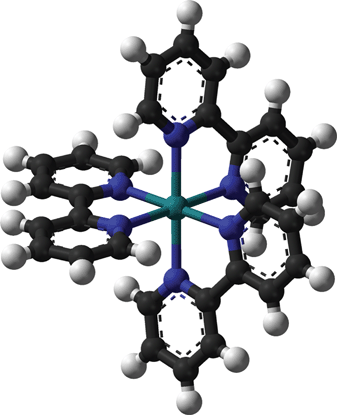 In their Tutorial Review, Narayanam and Stephenson provide a historical overview of using visible light to initiate organic reactions by employing Ru(II)polypyridine catalysts.
In their Tutorial Review, Narayanam and Stephenson provide a historical overview of using visible light to initiate organic reactions by employing Ru(II)polypyridine catalysts.
Download the Chem Soc Rev article to read about the recent developments in photoredox catalysis.
Chem Soc Rev in a nutshell: Fact number 2
Chem Soc Rev‘s latest impact factor was 26.583 (Thomson Reuters®, 2010) making us the second highest impact journal in chemistry. This is a third higher than the 2009 value and marks the third year in a row that we have seen a rise.
With analysis already underway for the 2011 impact factor, we’re predicting that next year will also be a success!
Visit the RSC Publishing blog to find out the impact factors for the other RSC journals.
Chem Soc Rev in a nutshell
In anticipation of Chem Soc Rev moving to 24 issues per year, we will be posting 24 facts about the journal – some well known, some not so well known, and some a little peculiar. Keep up-to-date with the blog page as we approach 2012, to ensure you don’t miss out on any Chem Soc Rev trivia!
And starting with Fact Number One…
| Chem Soc Rev started life under two different names. In 1972, Quarterly Reviews, Chemical Society and Royal Institute of Chemistry, Reviews joined to become Chemical Society Reviews. To browse all of our review articles dating back to 1947, visit the journal archive. |
